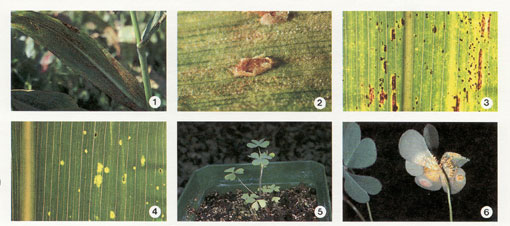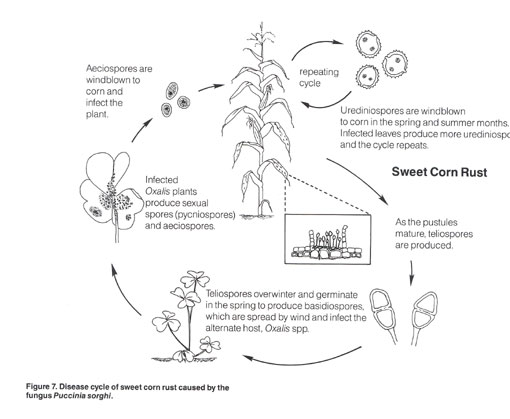Common rust on sweet corn is caused by the fungus Puccinia
sorghi. Epidemics of this disease can cause serious losses in yield and quality
of sweet corn. High rust susceptibility of many popular sweet corn hybrids is
a major factor contributing to rust epidemics. Another factor is that sweet corn
is usually planted over an extended period from May through June for fresh and
processing uses. The staggered planting schedules result in high concentrations
of fungal spores in the air, originating from early planted fields, at the time
when late-planted fields contain young actively growing susceptible plants.
Symptoms
and Signs
Common rust on sweet corn appears in
the field as oval to elongate cinnamon brown pustules scattered over upper and
lower surfaces of the leaves (fig. 1). The pustules rupture
and expose dusty red spores (urediniospores, fig. 2), which
are spread by wind and have the ability to infect other corn leaves directly.
As the pustules mature, they turn brownish black and release the dark-brown overwintering
spores (teliospores). In severe epidemics, pustules may also appear on the ears
and tassels, and the leaves may yellow and become easily tattered in strong winds.
Partial resistance is expressed as chlorotic or necrotic hypersensitive flecks
with little or no sporulation (compare fig. 3, susceptible,
and fig. 4, resistant).
Disease Cycle
The
complete life cycle of P. sorghi includes five different spore types
and two hosts, corn (c) and species of wood sorrel (Oxalis spp.) (
fig. 5). The spore types and the hosts they infect are teliospores (o), basidiospores
(o), pycniospores (o), aeciospores (c), and urediniospores (c). All spore types
occur in Mexico, but those involving the alternate host, Oxalis spp., are
of little importance in the life cycle of the fungus as it occurs in temperate
areas of the United States. The aecial stage (fig. 6, called
"cluster-cups") appears on the underneath surface of Oxalis leaves, producing
aeciospores, which are windborne and infect corn leaves. These infections give
rise to urediniospores, which are the most-important spore type in the northern
United States. Urediniospores occur on corn leaves throughout the growing season
and continue cyclic infections. The disease cycle for common rust is illustrated
in figure 7.
Severe rust epidemics
on dent corn have been rare because of the availability of resistant varieties.
However, rust epidemics on sweet corn have been severe, though somewhat sporadic.
Three major factors interact to influence the outbreak of rust epidemics on sweet
corn: (1) the quantity of urediniospores available to initiate rust epidemics,
(2) environmental factors, and (3) the level of rust susceptibility in the sweet
corn varieties in use. Urediniospores are unable to overwinter successfully in
northern climates. Each spring urediniospores move north from the southwestern
United States and Mexico, following the sequential plantings of corn from the
south up to Canada. Temperatures of 60° to 75° F (16-24° C) and
heavy dews or high relative humidity (close to 100%) favor rust development. The
current weather conditions influence spore germination and the rate at which rust
epidemics develop. Moisture is required for spore germination. Infection will
occur when leaves are wet for a minimum of 3 to 6 hours.

Cultural.
Although most of the current popular sweet corn hybrids are susceptible to
rust, resistant varieties are becoming available. Two types of resistance are
being used by commercial sweet corn breeders: race-specific resistance and partial
rust resistance. A partial list of hybrid reaction to rust severity at harvest,
from most to least resistant, includes aRRestor, Excellency, and Prevailer (possess
specific resistance with 0% rust severity and fungus unable to sporulate); Sweetie,
Miracle, Country Gentleman, Sucro, Sugar Time (partial resistance); Dandy, Gold
Dust, Golden Glade, Patriot, Tendertreat EH, Sugar Loaf (moderate resistance);
Seneca Horizon, Gold Cup, Seneca Sentry, Kandy Corn EH, Jubilee, Sweet Sal, Commander,
Stylepak, Merit, Silver Queen, Florida Staysweet, and Sweet Sue (least resistance).
Resistant or moderately resistant varieties should be used for late plantings
when fungal spore density in the air is likely to be high as a result of infections
of earlier-planted sweet corn. The varieties listed are examples only, and no
endorsement is implied. For suggestions on varieties adapted to New York growing
conditions, see Cornell Recommendations for Commercial Vegetable Production.
Fungicides.
Modest control of rust on sweet corn can be achieved with applications of
fungicides. Trials conducted in western New York have shown that three applications
of mancozeb applied by air significantly reduced disease severity on all the leaves
of sweet corn plants. Fungicide applications also significantly increased the
number of harvestable ears and the weight of the harvested ears. Secondary ears
tended to be more severely affected by rust than primary ears. Research conducted
in other states has shown that, by controlling rust with fungicides, improvements
in moisture content sugar content, and ear-tip fill were observed. Timing of the
first fungicide application is critical because it needs to be applied early enough
to reduce the rate of epidemic development. Because rust spores arrive from outside
the immediate area planted to corn, it is difficult to predict when this spray
should be applied. From research conducted in western New York, a 6-pustule-per-leaf
action threshold has been proposed for initiation of fungicide sprays on later
plantings of susceptible sweet corn. This threshold is only a guideline and is
still in the process of being validated.
Refer to the most
recent issue of Cornell Vegetable Recommends for registered products for
use on sweet corn and follow label directions.

Tidak ada komentar:
Posting Komentar
SERVE BETTER YOU